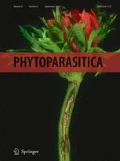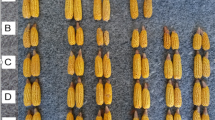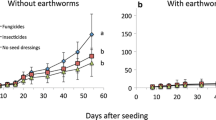Abstract
In field trials conducted at the Experiment Station and in a farmer’s field at Mbita near the shores of Lake Victoria, Kenya, applications of 2% or 3% neem seed extract (NSE) @ 200 l/ha with a knapsack sprayer at 38, 47 and 51 days after emergence (DE) of the cowpea crop or 5%, 10% or 20% NSE sprayed @ 10 l/ha with an ultra-low-volume applicator at 31, 39 and 49 DE often significantly reduced the number of larvae of the flower thrips,Megalumthrips sjostedti (Trybom), in cowpea flowers recorded 2 days after each treatment. Also fewer adults occurred in flowers at 51 DE in plots sprayed with 5%, 10% or 20% NSE. Cowpea grain yield was significantly higher in plots sprayed with 20% NSE than in untreated control plots and was comparable to the grain yield obtained in plots sprayed thrice with cypermethrin. Because of the low cost of NSE treatment, the net gain was often more when the crop was sprayed with NSE than with cypermethin. Also, grain quality was superior in neem-treated plots than in untreated or cypermethrin-treated plots.
Similar content being viewed by others
References
Alghali, A.M. (1991) Studies on cowpea farming practices in Nigeria, with emphasis on insect pests control.Trop. Pest Manage. 37:71–74.
Alghali, A.M. (1992) Insecticide application schedules to reduce grain yield losses caused by insects of cowpea in Nigeria.Insect Sci. Appl. 13:725–730.
Amatobi, C.I. (1994) Field evaluation of some insecticides for the control of insect pests of cowpea(Vigna unguiculata (L.) Walp.) in the Sudan Savannah of Nigeria.Int. J. Pest Manage. 40:13–17.
Ampong-Nyarko, K., Reddy, Seshu K.V. and Saxena, K.N. (1994) Reduction of insect pest attack on sorghum and cowpea by intercropping.Entomol. Exp. Appl. 70:179–184.
Dissemond, A. and Hindorf, H. (1990) Influence of sorghum/ maize/ cowpea inter-cropping on pest, disease, and weed situation at Mbita/Kenya.in: Proc. Integrated Pest Management in Tropical and Sub-tropical Cropping Systems (Frankfurt, Germany), pp. 843–851.
Dreyer, M. (1986) Untersuchungen zur Wirksamkeit von Wasserextrakten und anderen Produkten aus Niemsamen gegen Schädlinge an Gemüse— und Feldkulturen in Togo. Doctoral thesis, Univ. of Giessen, Germany.
Ezueh, M.I. and Taylor, A.T. (1984) Effects of time of intercropping with maize on cowpea susceptibility to three major pests.Trop. Agric. 61:82–86.
Freisewinkel, D. (1989) Freilanduntersuchungen zur Wirkung von Niemextrakten gegen Schadlinge in Zwiebelkulturen in der Dominikanischen Republik. Diploma thesis, Univ. of Giessen, Germany.
Grahn, B. (1989) Untersuchungen zur Wirksamkeit von Niemsamen-wasserextrakten gegen verschiedene Insekten in Ägypten. Diploma thesis, Univ. of Giessen, Germany.
Hongo, H. and Karel, A.K. (1986) Effect of plant extracts on insect pests of common beans.J. Appl. Entomol. 102:164–169.
Immaraju, J.A., Morse, J.G. and Hobza, R.F. (1990) Field evaluation of insecticide rotation and mixtures as strategies for citrus thrips (Thysanoptera: Thripidae) resistance management in California.J. Econ. Entomol. 83:306–314.
Ivbijaro, M.F. and Bolaji, O.O. (1990) Effects of cypermethrin + dimethoate and extracts ofPiper guineense andAzadirachta indica on the pests and yield of cowpea,Vigna unguiculata.J. Agric. Sci. 115:227–231.
Jackai, L.E.N. (1993) The potential of neem in controlling cowpea pests.Int. Inst. Trop. Agric. Res. 7: 5–11.
Jackai, L.E.N. and Daoust, R.A. (1986) Insect pests of cowpeas.Annu. Rev. Entomol. 31:95–119.
Kyamanywa, S., Balidawa, C.W. and Ampofo, K.J.O. (1993) Effect of maize plants on colonisation of cowpea plants by bean flower thrips,Megalurothrips sjostedti.Entomol. Exp. Appl. 69:61–68.
Lindquist, R.K. and Casey, M.L. (1990) Evaluation of oils, soaps, and natural product derivatives for leaf miner, foxglove aphid, western flower thrips, and greenhouse whitefly control.Ohio Florists Assoc. Bull. 727:3–5.
Marconi, E., Lombardi-Boccia, G., Carnovale, E. and Ng, N.Q. (1990) Nutritional evaluation of wild and cultivated species of cowpea.in: Ng, N.Q. and Monti, L.M. [Eds.] Cowpea Genetic Resources. Int. Inst. Tropical Agriculture, Ibadan, Nigeria. pp. 101–118.
Matteson, PC. (1982) The effects of intercropping with cereals and minimum permethrin applications on insect pests of cowpea and their natural enemies in Nigeria.Trop. Pest Manage. 28:372–380.
Matthews, G.A. (1979) Pesticide Application Methods. Longman, London, UK.
Mensah, G.W.K. (1988) Relative effectiveness of insecticide sprays on insect damage and yield of three cowpea cultivars in Swaziland.Insect Sci. Appl. 9:101–108.
Nangju, D., Flinn, J.C. and Singh, S.R. (1979) Control of cowpea pests by utilisation of insect-resistant cultivars and minimum insecticide application.Field Crops Res. 2:373–385.
Olowe, T., Dina, S.O., Oladiran, A.O. and Olungua, B.A. (1987) The control of weed, pest, and disease complexes in cowpea (Vigna unguiculata (L.) Walp.) by the application of pesticides singly and in combination.Crop Prot. 6:222–225.
Pillai, M.A.K. and Pooniah, S. (1988) Neem for control of rice thrips.Int. Rice Res. Newsl. 13(5):33–34.
Rachie, K.O. (1985) Introduction.in: Singh, S.R. and Rachie, K.O. [Eds.] Cowpea Research, Production and Utilization. Wiley, Chichester, UK. pp. xxi-xxviii.
SAS Institute. (1987) SAS/STAT User’s Guide, 6th ed. SAS Institute, Cary, NC, USA.
Saxena, R.C. (1989) Insecticides from neem.in: Arnason, J.T., Philogène, B.J.R. and Morand, P. [Eds.] Insecticides of Plant Origin.ACS (Am. Chem. Soc.) Symp. Ser. 387, pp. 110–135.
Schmutterer, H. [Ed.] (1995) The Neem TreeAzadirachta indica A. Juss. and Other Meliaceous Plants: Source of Unique Natural Products for Integrated Pest Management, Medicine, Industry and Other Purposes. VCH, Weinheim, Germany.
Singh, S.R. and Jackai, L.E.N. (1985) Insect pests of cowpeas in Africa: their life cycles, economic importance and potential for control.in: Singh, S.R. and Rachie, K.O. [Eds.] Cowpea Research, Production and Utilization. Wiley, Chichester, UK. pp. 217–231.
Singh, S.R., Jackai, L.E.N., Dos Santos, J.H.R. and Adalla, C.B. (1990) Insect pests of cowpea.in: Singh, S.R. [Ed.] Insect Pests of Tropical Food Legumes. Wiley, Chichester, UK. pp. 43–89.
Singh, S.R. and Taylor, T.A. (1978) Pests of grain legumes and their control in Nigeria.in: Singh, S.R., Van Emden, H.F. and Taylor, T.A. [Eds.] Pests of Grain Legumes: Ecology and Control. Academic Press, London, UK. pp. 99–111.
Tamo, M., Baumgartner, J., Delucchi, V. and Herren, H.R. (1993) Assessment of key factors responsible for the pest status of the bean flower thripsMegalurothrips sjostedti (Thysanoptera: Thripidae) in West Africa.Bull. Entomol. Res. 83:251–258.
Tanzubil, P.B. (1991) Control of some insect pests of cowpea(Vigna unguiculata) with neemAzadirachta indica A. Juss.) in northern Ghana.Trop. Pest Manage. 37:216–217.
Author information
Authors and Affiliations
Rights and permissions
About this article
Cite this article
Saxena, R.C., Kidiavai, E.L. Neem seed extract spray applications as low-cost inputs for management of the flower thrips in the cowpea crop. Phytoparasitica 25, 99–110 (1997). https://doi.org/10.1007/BF02981190
Received:
Revised:
Issue Date:
DOI: https://doi.org/10.1007/BF02981190




